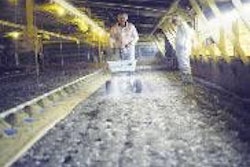
There was once an animal industry in North America which provided jobs, raw materials for other products and utilized what were scientifically accepted humane slaughtering techniques. This industry had flourished for decades and had become an important part of the local economy, but when video was circulated showing how the animals were “humanely” slaughtered, the public outcry was such that the industry became a pariah overnight. Dr. Wes Jamison, associate professor of agriculture, Dordt College, used the story of the baby harp seal harvest or hunt in Canada as a parable for what could happen to the poultry industry in the future if it allows the reality of its practices to stray too far from what society expects.
Jamison, speaking at the U.S. Poultry & Egg Association Poultry Care and Handling Workshop held recently in Memphis, Tenn., said that video of the seal hunt gave the public a window into the industry that it had lacked before. The seals were killed in the open on the ice with clubs that had metal spikes in them, and this practice had been considered humane. Jamison said that the demise of the seal hunt resulted because the previously accepted legitimate production practice, clubbing the seal, was no longer in harmony with society’s expectations for humane animal treatment. The video rendered scientific and economic arguments irrelevant, according to Jamison. He said, “Animal use exists in a social context; if that context changes, then the animal use must change.”
Jamison said that the poultry industry needs to be aware of society’s changing values, particularly those that pertain to animals. Pets hold a special place in most American homes. In an Ohio State University survey, 81 percent of respondents said that farm animal well-being is as important as pet well-being. Would these four-fifths of the U.S. population accept what they would see in a candid video of broilers or turkeys being caught on the farm, or birds being hung or slaughtered at the plant? Is this how their pets are treated? Jamison’s presentation helped to reinforce the seriousness of the animal welfare issue for the future of the poultry industry and the importance of the information presented by the other speakers at the conference.
Are the lights on?
Dr. Tim Cummings, clinical professor, Mississippi State Veterinary School, speaking on the topic, “Welfare Aspects of Practical Lighting Programs,” relayed a story of how a welfare audit can raise hard-to-answer questions about standard industry practices. Cummings and other researchers at Mississippi State were asked by Sanderson Farms to investigate the effect of lighting levels on welfare of broilers so that the company could address questions raised during a customer-required animal welfare audit. Cummings reports that the auditor said, “Raising chickens in buildings so dark that seeing the chickens is difficult is not acceptable.”
The broiler industry utilizes lighting programs to optimize broiler health and performance by slowing early growth. Typical programs utilize brighter intensity and longer day length early, up to around three weeks of age, followed by decreased light intensity up until market age. Lighting programs vary greatly among integrators and depend on whether houses have curtains or solid-sidewalls.
Cummings said that there are a few reasons why light levels in broiler houses might be questioned from a welfare standpoint. In the United Kingdom, legislation sets the minimum for light intensity for broiler houses at 0.929 foot candles, which is significantly brighter than the light levels used by many U.S. integrators in solid-sidewall housing. Research has shown that continuous dark conditions can cause eye abnormalities and/or pain. Ocular changes can be induced by both continuous lighting as well as dark-out conditions, according to published reports. Lesions found usually included eye enlargement and increased inter-ocular pressure (IOP). Finally, Cummings asked the basic question, “Will the public understand low light conditions in broiler houses?”
Mississippi State researchers tested to see what effects low light intensity has on the behavior of the broilers, to see whether varying the light intensity will induce any form of eye pathology and to see if it is stressful to raise birds under low light conditions. In their first study, they went to a farm that had market age birds raised in both curtain-sided houses and solid-sidewall houses. IOP measurements were taken of birds in both houses, and the tonic immobility of birds was also tested. Tonic immobility is a method of measuring fear response.
Birds in the solid-sidewall houses were more docile and easier to catch. Birds in both types of housing were seen to be readily moving to drinkers and feeders. There was much more aggressive posturing in the curtain-sided houses and less pecking and preening in the solid-sidewall facility. The curtain-sided houses had 15 foot candles of light, and the solid-sidewall houses had 0.03 foot candles of light. No discernable pathology was identified in the eyes of birds in either lighting condition. Bird behavior is modified by different lighting intensities, and there was an indicator, tonic immobility response, that a low light intensity program in this comparison was less stressful.
A second study compared a controlled lighting program of 24 hours of light at 0.03 foot candles from 23 days of age until market at 60 days of age with lighting programs that varied the light intensity in commercial houses. For both of the test groups, the higher light intensity was 0.3 foot candles, and the lower intensity was 0.03 foot candles. The high- and low-light intensities were alternated on an eight-hour, high-intensity and 16-hour, low-intensity cycle for one test group and four high-, four low-, four high- and 12 low-intensity cycles for the other test group.
In this study, brighter lights increased body weights, but the lower light intensity program improved feed conversion, lowered standard costs, resulted in better gait scores and demonstrated lower corticosterone levels in the blood of the birds. Most production parameters were improved by utilizing the standard, low-intensity lighting program. Lower corticosterone levels, believed to be an indicator of reduced stress, and improved gait scores may help explain this improvement. Cummings said, “This issue (animal welfare) has and will significantly change the way we do business. It will only grow in importance. As an industry, we can and should do better in some areas. We better get involved with the debate and science at every opportunity.”
Gas stunning options
Dr. A. Bruce Webster, poultry science professor, University of Georgia, said that commercially available controlled atmosphere stunning (CAS) systems were designed to minimize handling of the birds, because the birds are stunned prior to shackling, and to minimize carcass damage. Several different gas mixtures and methods of stunning or killing are being used, and there has been debate over the relative merits from an animal welfare standpoint of the various gas mixtures and techniques for administering the gas.
Types of CAS Systems
•Anoxia – single-stage – argon, nitrogen gases, stun-to-kill
•Hypercapnic anoxia – single-stage – 30 percent carbon dioxide with argon or nitrogen, stun-to-kill
•Hypercapnic hypoxia – single-stage or multi-stage – carbon dioxide and air – stun or stun-to-kill, systems being used at four USA turkey plants
•Hypercapnic hyperoxygenation – two-stage – 30 percent carbon dioxide, 30 percent oxygen and 40 percent nitrogen, stun only
Some researchers and animal welfare advocates have questioned the merits of carbon dioxide use in CAS systems, because birds are able to recognize the presence of carbon dioxide and show a natural aversion to the gas. Webster pointed out that carbon dioxide has several characteristics that are beneficial for use in CAS systems. Carbon dioxide produces anesthesia during the stunning process, and it can reduce convulsions associated with anoxia. Also, carbon dioxide is readily available and relatively inexpensive and, since it is heavier than air, it is relatively easy to contain.
Webster has conducted a series of experiments where various gas mixtures are tested on broilers, and the broilers’ behavior is videotaped and the birds’ physiological responses to the gases are monitored. Webster said that broilers do recognize presence of carbon dioxide, and it does cause headshaking, which is believed to be a reflection of irritation caused by high carbon dioxide in the nares and throat. Argon also causes headshaking, but Webster said it was a different kind of headshaking than what happens with carbon dioxide. He said that headshaking may be an alerting response where the bird is trying to wake themselves up from the anesthetic effect of the carbon dioxide.
Webster showed videos of birds being killed using several different gas mixtures, and it is important to note that in all cases the birds do “move around” or convulse in some manner. None of the gas mixtures produce a motionless death, so video of birds inside a CAS would not necessarily be any nicer to show the public than would video of birds in the blood tunnel using traditional electrical stunning and slaughter techniques.
Carbon dioxide causes some aversion in chickens at all concentrations, but Webster said that this is not a strong aversion response. Webster’s research in this area was done with hens. A CAS working group, which comprised European and American researchers on CAS and United Kingdom government representatives, was convened in May 2005 to review existing research on CAS and come up with recommendations. The working group concluded that welfare-related differences exist between CAS gas mixtures, but that these differences are not so great or unilateral as to give one gas mixture an advantage over the others.
Vacuum stunning
Research is being conducted on another method of stunning and killing poultry. Dr. J. Paul Thaxton, Mississippi State University, Dr. Jodie Purswell and Dr. Scott Branton, both with USDA ARS, reported on low atmosphere stunning for broilers at the Poultry Science Association meeting this summer. A chamber was designed for reduced atmosphere killing that allows for brainwave tracings (EEGs) and heart-wave tracings (EKGs) to be taken from the birds. The chamber was telemeterized so that signals were sent to the computer and recorded. Thaxton said it takes about 30 seconds to pull the pressure down to about 20 percent of normal atmospheric pressure in the chamber, or 80 percent vacuum. Within 30 seconds, at 80 percent vacuum, the birds were dead, and the average time was 22 seconds to give a flat brainwave tracing. Thaxton said the birds have a “tonic-type seizure” where the muscles start flapping around. Tonic seizure means that there is no sentient information going into the brain. The only signals that the brain is receiving are for the uncontrolled muscle movement and none for pain. Two seconds after the flat brainwave tracing, the birds had a flat heart-wave tracing.
Thaxton said that, in 2001, the Journal of the Veterinary Medical Association published a set of recommendations for euthanasia procedures, or humane ways to kill animals. They listed reduced atmospheric pressure as an inhumane way to kill an animal, and this conclusion was based on work done with cattle. First, they said that you can trap air in spaces within the body cavity and that this can cause agonizing pain as the animal approaches death. Second, young animals are resistant to hypoxia, and this means that they can die slowly and in pain. Reduced atmosphere was also thought to be painful because it causes grand mal seizures and defecation of the animal.
Thaxton is an avian anatomist and physiologist and he explained that the respiratory system of the bird is unique and extremely different from that of any other animal. Birds evolved to fly, so they have about seven times the respiratory capacity of a human because of all of the air sacs scattered throughout the body, and the lungs are fixed and do not work like bellows. The biggest problem with modeling the avian respiratory system is that if you put any pressure in the system then air leaves one space and goes into another; there is no trapping of air, it simply moves around at random depending on muscle movements of the bird. “You cannot trap air and cause pain in a bird, it cannot happen physically in a bird,” Thaxton said. The AVMA did not have a bird specialist on its panel. Thaxton thinks that the research data will be sufficient to overcome the current AVMA stance on vacuum stunning.
Vacuum stunning kills the birds by crushing the lungs and when the lung is crushed, there can be no more oxygen exchange. In experimental work, bleed-out of the birds following vacuum stunning has been as good as bleed-out following traditional electrical stunning, and blood clotting is delayed. Thaxton said that vacuum stunning can be done in a minute versus the two to three minutes that it takes for CAS. This might provide a welfare advantage.
Techno-Catch, LLC, has patented the vacuum stunning process and is funding this research. The company has developed a prototype vacuum stunning system, which will stun an entire industry standard size cage of broilers, and the company has begun testing the unit at an integrated company.


















